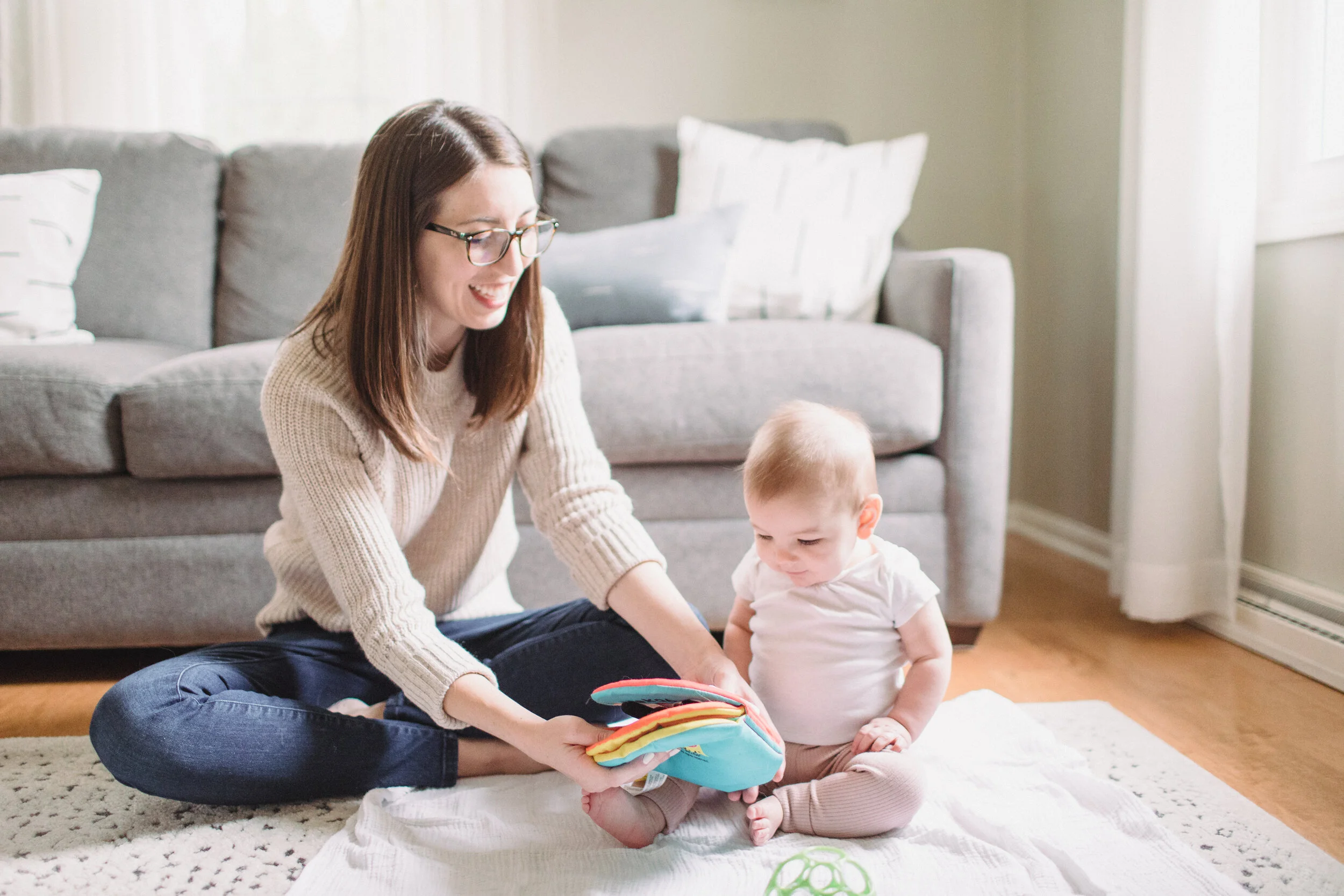Why reading is important for babies
Children who are read to regularly at home throughout early childhood will be exposed to exponentially more words than their peers who are not regularly read to.
By the time they reach kindergarten, children will have heard 290,000 more words if read 1 book each day and 1.4 million more words if read 5 books each day (Logan, et al., 2019). When children are not read to at home, the research has found that this “million word gap” exists and likely has consequences on vocabulary development and academic success in kindergarten and beyond.
The good news? Reading is a great way to work on building strong connection and bonding with your baby, it encourages speech and language development, and can be incorporated into the floor time play you are already doing with your baby.
Get more tips on
General Reading Play Tips
Add book reading to a routine you’re already doing each day like before nap/bedtime or before or after a meal.
Keep a few books in each room of the house where you spend time each day.
Make library trips a regular part of your week and enjoy new (and free!) books and bonus if you catch a story time while you're there!
Tips for reading to your 0-3 month old
Taking a few minutes each day to read to your baby from day one is a great way to start bonding and pass the time together during those sleep deprived first weeks and months.
Reading any book together is great, but to maximize your time spent reading to your brand-new baby, we recommend incorporating the following when you can throughout the day.
Choose high-contrast black and white books or books with photos of real faces
Speak slowly, use a soft voice and make reading a calming and bonding experience
Try positioning baby on her side while pointing to pictures on the page
Read to baby during floor time with book 8-12 in from her face where vision is well developed
Some of our favorite books with real faces are the Global Baby series. Wonderful bright photos featuring babies from all over the world.
Tips for reading to your 3-6 month old
During your baby’s third through sixth months he will develop the ability to see more colors and will learn to watch and follow a person walking across the room or a toy moving up and down without losing control of his head. This opens up a whole new world for your baby to explore and makes reading together even more fun.
Reading any book together is great, but to maximize your time spent reading to your 3-6 month old baby, we recommend incorporating the following when you can throughout the day:
Choose books with simple pictures or books with touch-and-feel pages
Turn and face baby so he can watch your mouth as you read
Read to baby during floor time
Prop the book up so it stands by itself, that way baby has to look up to see the page instead of looking down at the floor while on his tummy
Tips for reading to your 6-9 month old
Reading just keeps getting more fun with your baby! By month 9 your baby will likely be able to sit upright, turn pages with help, and use gestures/imitate motor movements.
Reading any book together is great, but to maximize your time spent reading to your 6-9 month old baby, we recommend incorporating the following when you can throughout the day:
Choose books with lift-the-flap pages
Point to pictures in the book and make big facial expressions paired with gestures (e.g., “oh no!” or waving “hi!” & “bye bye!”)
Place a book a few feet away on the floor so baby has to move to go get it, or put a few books in a semicircle around baby so she has to pivot on her belly to look at them all
Hold the book at baby’s eye level, not down low, so she has to work her trunk more while sitting
Tips for reading to your 9-12 month old
By age one your baby will likely be able to point, clap, imitate sounds and simple syllables.
Reading any book together is great, but to maximize your time spent reading to your 9-12 month old baby, we recommend incorporating the following when you can throughout the day:
Choose books with simple, repetitive language
After you’ve read the book many times, start pausing before ending predictable phrases “peek-a- “ *pause and look at baby briefly* and then finish with an excited “boo!”
Encourage baby to help turn the pages while he’s sitting
Point to items on the page and help baby copy you
Place a book up on the couch cushion to encourage baby to move to go get it
Reading is a skill that helps support bonding, language and so much more. If there is anything we didn’t cover and you want to know about choosing a book or HOW to read with your baby, please leave us a comment below!
Stay up to date and join us for
-Jaclyn
We’re Jaclyn & Bree
Pediatric therapists and moms with a mission to empower you with knowledge to encourage your baby’s development and continue confidently into your parenthood journey.
If you have any questions, please feel free to leave a comment below and we will get back to you. As always, the information we share is meant to provide general education and tips and is not intended as medical advice. If you have a specific question or concern about your child’s development, please speak directly to your child’s doctor or therapist.







